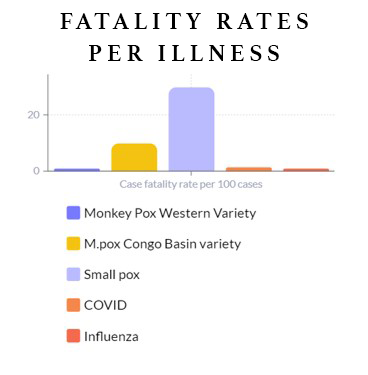Estimated reading time: 5 minutes
So, what is monkeypox? 1958 brought the discovery in monkeys of a relative to the deadly Smallpox virus. It was named…the Monkeypox virus. Fortunately, Smallpox was eradicated in 1980, and the last case was noted in 1977. There is rare animal to human transmission with Monkeypox and the first case occurred in 1970. It is primarily in Central and West Africa. There are two varieties, the Congo basin variety, which seems to be more deadly, and the less lethal West African variety. Most cases in humans come from contact with mammals and their body fluids. Cases are rare outside of Africa. Human to human transmission is also very unusual, and when it occurs, it is through large respiratory droplets, so close prolonged contact is necessary. Since 1958 we have gone from discovery to having a monkeypox treatment via vaccine.
brought the discovery in monkeys of a relative to the deadly Smallpox virus. It was named…the Monkeypox virus. Fortunately, Smallpox was eradicated in 1980, and the last case was noted in 1977. There is rare animal to human transmission with Monkeypox and the first case occurred in 1970. It is primarily in Central and West Africa. There are two varieties, the Congo basin variety, which seems to be more deadly, and the less lethal West African variety. Most cases in humans come from contact with mammals and their body fluids. Cases are rare outside of Africa. Human to human transmission is also very unusual, and when it occurs, it is through large respiratory droplets, so close prolonged contact is necessary. Since 1958 we have gone from discovery to having a monkeypox treatment via vaccine.
Update: May 22, 2023
It’s now been a year and the US has 30,395 cases and 42 deaths. The first case since January 2023 occurred in Maricopa County in Arizona. Total US Monkey Pox vaccines given are over 1 million.
Table of contents
Monkeypox In Humans
There are six cases in the UK, four in Portugal and Spain, and one currently in Massachusetts in someone who had traveled to Canada, where there are currently no known cases. In 2021, there was one case in Texas and one in Maryland, both related to travel to Africa. Forty-seven cases occurred in six US states in 2003, all traced back to pet prairie dogs in contact with infected imported mammals from Ghana. There were no deaths in that outbreak.
Update: September 14, 2022
There are now over 22,000 cases in the USA and nearly 60,000 worldwide. In the US, more than 60% of the cases occur in New York, California, Illinois, Washington DC, and Florida. The first US death from monkeypox was recently in Los Angeles. There have been 19 reported deaths worldwide. All deaths are in immune compromised patients. Despite the increasing numbers and now with a few deaths, it is still thought to be primarily spread by direct skin to skin contact, but there are some airborne cases now. It is still overwhelmingly a generally self-limited disease that usually does not need treatment. Overt 97% of cases are related to men having sex with men, (MSM). The recent cases seem to be different than classically in Africa. Instead of a widespread blister like rash, many have a small localized rash like a pimple or a blister. It can be localized to the anal or genital area, even in the mouth. Still, it does spread diffusely on the skin as you’ve seen in some pictures probably. It can be mild or very painful in nature. It seems to be seen primarily in men having sex with men. To date there is now some evidence it is air-borne, but typically requires close contact. Complications can occur such as with an encephalitis, or a brain infection.
Is Monkeypox Dangerous?
The current case in Massachusetts seems to be related to the less dangerous West African variety. Case death rate in that variety is 1 in 100. In the Congo basin variety, the death rate is more like one in 10. For comparison, smallpox was three in 10 or 30%. COVID, on the other hand, has a lethality rate of just over 1% per 100 cases, of course, higher lower based on your age and overall health status. The typical influenza death rate is less than one in 100 cases.
Symptoms Of Monkeypox

Monkeypox symptoms are flulike with headaches, fevers, chills, body aches, and swollen lymph nodes. There is a rash that looks like a chickenpox rash. It starts as a flat red spot, becomes raised, and turns into a blister or vesicle, then it dries and crusts over, which is similar to the chickenpox rash sequence. The illness lasts 2 to 4 weeks and typically has a benign course. Monkeypox is not currently considered to be an STD/STI. The current cases seem to be occurring in people engaging in gay or bisexual sex. This is likely related to body fluid exposure.
are flulike with headaches, fevers, chills, body aches, and swollen lymph nodes. There is a rash that looks like a chickenpox rash. It starts as a flat red spot, becomes raised, and turns into a blister or vesicle, then it dries and crusts over, which is similar to the chickenpox rash sequence. The illness lasts 2 to 4 weeks and typically has a benign course. Monkeypox is not currently considered to be an STD/STI. The current cases seem to be occurring in people engaging in gay or bisexual sex. This is likely related to body fluid exposure.
Monkeypox Treatment
Monkeypox treatment comes via vaccine and antivirals that seem to be effective against it, but none of these have been proven to be highly effective. The US has a stockpile of 100 million older generation smallpox vaccines and much less of the newer generation type, but manufacturing is ramping up. In short, this is not something to worry about in your everyday lives unless you have high-risk behavior associated with high-risk monkeypox exposures, you hunt in West Africa, or you have high-risk travel. Compared to COVID, the transmission rate is very low, and we know this because we’ve been aware of this virus for over 60 years. This is not like COVID, which sprang onto the world completely new and novel with no previous history.
and antivirals that seem to be effective against it, but none of these have been proven to be highly effective. The US has a stockpile of 100 million older generation smallpox vaccines and much less of the newer generation type, but manufacturing is ramping up. In short, this is not something to worry about in your everyday lives unless you have high-risk behavior associated with high-risk monkeypox exposures, you hunt in West Africa, or you have high-risk travel. Compared to COVID, the transmission rate is very low, and we know this because we’ve been aware of this virus for over 60 years. This is not like COVID, which sprang onto the world completely new and novel with no previous history.
To your good health which should be free of monkeypox concern,
Kevin McCurry, MD
Join my Substack Newsletter
recent posts
Estimated reading time: 8 minutes Set to affect 12 million people by 2040, is linked to viruses like COVID-19, its symptoms include tremors and slow movements, significantly impacting daily life....
This article provides an overview of turmeric, a traditional food spice used in Chinese and Ayurvedic medicine. It discusses the safety of turmeric and its active ingredient, curcumin, and how it may...


